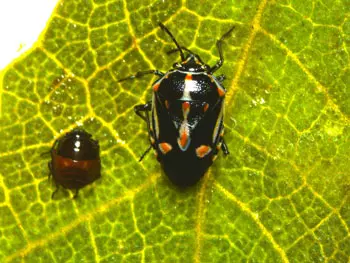Bagrada Bug

The Bagrada Bug is an invasive stink bug that attacks many vegetable crops (their favorites being: cabbage, kale, Brussel sprouts, cauliflower, mustard, broccoli, radish), and several different species of ornamental plants. These stink bugs reproduce quickly and their large numbers cause a considerable amount of damage very quickly.
Native to Africa, the Bagrada Bug was first found in Los Angeles County in 2008 and has been steadily spreading throughout California. It has unfortunately invaded Santa Clara this year and we’ve had a number of homeowners and growers contacting our department about it.
Why is it a problem?
We have native stink bugs in California but most of our natives lay their eggs on leaves, which leave them vulnerable to predatory wasps. Bagrada bugs will sometimes lay their oval creamy-white eggs on leaves, but their favorite spot to lay their eggs is in the soil underneath host plants. Laying their eggs in the soil protects them from predatory wasps, who can’t find their eggs to parasitize them.
How do you control this pest?
Detecting the Bagrada Bug early is important because populations grow very quickly. Be sure to monitor plants and remove stink bugs when you find them. Stink bugs are most active when it is 75° F or warmer outside, so scouting in midafternoon is recommended. If you have a large piece of cardboard or a sturdy sheet of paper, place it under plants and beat / shake the plant to knock the bugs onto the cardboard / paper. Slide the stink bugs into a bucket of soapy water to drown them. If you discover large numbers of stink bugs, get a shop vac and vacuum the bugs. They can be hardy and can survive the trip into the shop vac, so dump them into a bucket of soapy water.
There are commercial stink bug traps available, but be aware the lures won’t work for bagrada bugs. You may need to bait the traps with some of their favorite foods.
Pesticides can be used, but stink bugs are known to be difficult to manage with insecticides. Cultural methods like removing weed hosts in and near planting areas, and removing plant residue after harvest can be successful in reducing numbers. For more information visit the University of California Agriculture and Natural Resources page on Bagrada Bugs.